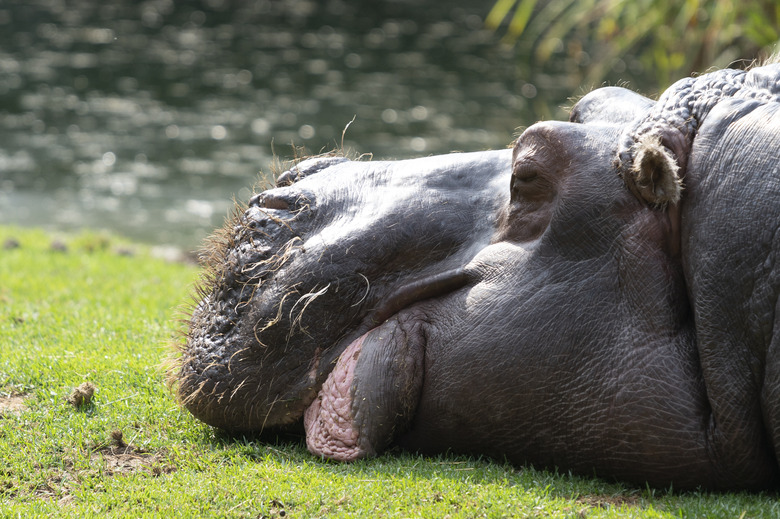Facts About Hippos
The chubby grey hippopotamus won't win any prizes for prettiness, with its chunky tusks and webbed feet, but it is the third largest animal that lives on land in the world. Hippo groups have social structures and etiquette, and the animal has formidable weapons at its disposal, which can be dangerous to humans. On the other hand, hippos are edible and the meat is highly prized in some areas of the world, so they are potentially more at risk from humans than we are at risk from them.
Hippo Characteristics
Hippo Characteristics
Hippos are mammals and are scientifically known as Hippopotamus amphibius. In Greek, hippo means horse and potamus means river, so the animal is a "river-horse." Historically, hippos lived all over the African continent, but in the 21st century, they only live in East Africa and in restricted, scattered locations across central and West Africa. How much does a hippo weigh? Hippopotamus amphibius can weigh up to 8,000 lbs.
TL;DR (Too Long; Didn't Read)
The pygmy hippo, Hexaprotodon liberiensis (or Choreopsis liberensis), is a separate species and much smaller than its more well-known cousin.
Behavior in the Wild
Behavior in the Wild
Hippos spend the majority of their time in rivers and lakes. They like to stay in water to keep cool amid the intense heat of the African sun. When they want to warm up, they bask in the sun on the shore, particularly in the morning. Hippos produce a red oily substance that helps keep their skin supple and even acts as a sunblock. Historically, people mistakenly believed that the hippos perspired blood because of the oil's color.
Groups of approximately 15 hippos live together, which helps to protect against attack by lions, crocodiles and hyenas. The most powerful male hippo leads the group and defends his position against challengers for leader through physical fights. A mother hippo gives birth either in the water or on land, but the baby hippo can feed underwater and keep up with its mother in the water. If it gets tired, sometimes the baby rests on the mother's back.
Food and Foraging
Food and Foraging
Hippos are herbivores and eat an average of 80 lbs. of grass per day. The animal can also eat plants that grow in water and the foliage of land plants. In zoos, keepers feed them hay, fruits and cereal grains. Usually, the animal grazes after the sun has set. The hippo can cover as much as six miles during the night looking for grass, and a group tends to walk in single file to get to the food source.
Endangered Pygmy Species
Endangered Pygmy Species
West Africa is home to a species of hippo known as Hexaprotodon liberiensis, or Choreopsis liberensis, which is smaller than Hippopotamus amphibius. This species, also called the pygmy hippo, lives in the forest and moves around alone. It only reaches a maximum weight of about 600 lbs. and has longer legs and a smaller head than its larger cousin. The pygmy hippo produces white, instead of red, skin secretions. Africa holds only a few thousand pygmy hippos and the species is listed as "endangered". In comparison, Hippopotamus amphibius is so common in some parts of Africa that governments need to kill some of them to keep the population down. However, overall populations are declining and the species is considered "vulnerable".
Cite This Article
MLA
O'Keeffe, Jillian. "Facts About Hippos" sciencing.com, https://www.sciencing.com/hippos-8457264/. 22 November 2019.
APA
O'Keeffe, Jillian. (2019, November 22). Facts About Hippos. sciencing.com. Retrieved from https://www.sciencing.com/hippos-8457264/
Chicago
O'Keeffe, Jillian. Facts About Hippos last modified March 24, 2022. https://www.sciencing.com/hippos-8457264/
